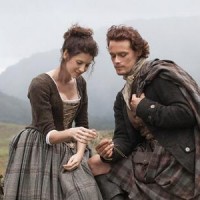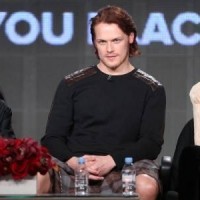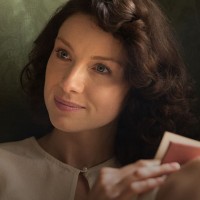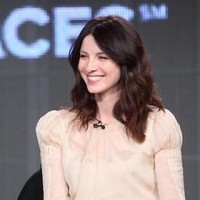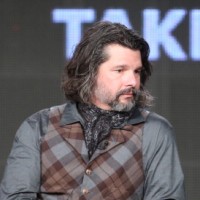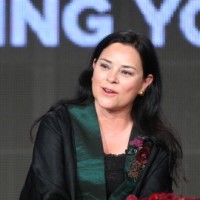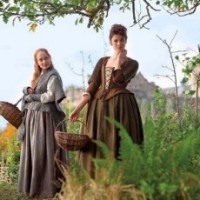Interview with OUTLANDER EP Ron Moore, creator Diana Gabaldon, stars Sam Heughan & Caitriona Balfe
Maj Canton - January 12, 2014
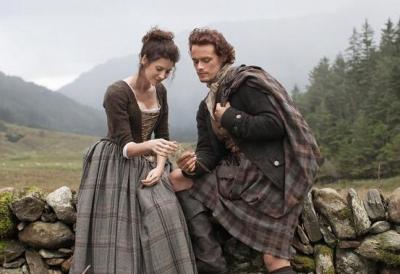
Friday at the Television Critics Association (TCA) Winter Press Tour, Starz presented an OUTLANDER press panel that included Executive Producer Ronald D. Moore, creator and author Diana Gabaldon, and series stars Sam Heughan and Caitriona Balfe. Answering journalists' questions, the group dished about filming the new series in Scotland, discussed being part of "Outlander" fandom, and chatted about kilts and tatan. We edited the panel's proceedings for clarity and readability, and added photos from TCA and the upcoming series.
OUTLANDER is scheduled to premiere on Saturday, August 9, 2014 at 9pm ET/PT on Starz.
|
|
|
|
Question: What is OUTLANDER about? Ronald D. Moore: Well, it's a big story. We're shooting it on location in Scotland, and probably the best way to show you some of the show is to show you some of the show. So we have a piece that we put together. It's sort of a sizzle reel, not really laying out the detail, but I think it gives you a sense of the location, the texture, and sort of the tone that we're going for. |
|
Question: Could you talk about the challenge of being faithful to the work while working with a different medium? Diana Gabaldon: Television is a different medium and to do a literal page by page translation of the screening would just not be a very good TV show.
|
|
|
|
|
|
|
Sam Heughan at TCA. (Photo credit: Starz) |
Question: Have you ever acted before in a kilt? Ronald D. Moore: I have several kilts now.
Question: Does it take a while to get used to acting in a kilt? |
|
Sam Heughan (continued): The Highlanders would wear them to obviously keep themselves warm. You could use is it as a sleeping bag. You could use it as camouflage to blend into the background. They had sort of a variety of uses. They also had lots of pockets and you could wear them in different ways. So, yeah, it took a long time to get used to it, but it's a real joy to work with it, and you can find various uses. I mean, we even discovered you can use it as a shield -- you can wrap around your arm. Ron could probably tell you more, but Terry really sourced all the materials as well. She went back to the beginnings. All the colors you see are taken from the environment, so natural herbs or berries.
Ronald D. Moore: Terry is our costume designer. She also happens to be my wife and she likes this Kinsey Tartan that we use in the show, which is also Sam's kilt. But she went back and basically did research to discover that what we think of as tartans and kilts in the contemporary sense were really a reinvention that happened in the 19th century. There was this romantic period where people were looking back and reinventing the idea of what kilts were, but our show is set in the 18th century, and actually in those days, these are closer to the colors that they actually used because they didn't have access to the bright dyes of reds and pinks. Also, if you're wearing red and pink in the forest, you tend to stand out, so this is sort of closer to what they actually used. We actually had these patterns made specifically for the show, and that just sort of gives you an idea basically that we approached the series with an eye towards authenticity, towards being real for what really happened in the 18th century, and for delivering a real world and not really reinventing it for modern sensibility. Sam Heughan: And are you finding it freeing and liberating? Ronald D. Moore: You know, it's funny. Here, heads turn when you walk around. If you wear it in Scotland, it's like nobody even notices.
Question: Caitriona, does it feel fun to be the only person on the panel who gets to wear slacks? Caitriona Balfe: I know. Well, we all know who wears the pants in this relationship. |
|
|
|
|
|
Question: There's a scene in the book that's very pivotal where Jamie beats the crap out of Claire. Diana Gabaldon: Well, that's putting it a little strong, maybe.
Question: Okay. How do you handle that in the series? |
|
Question: How are you dealing with that? Diana Gabaldon: Yeah, just to clarify, he doesn't beat the crap out of her. He spanks her bottom with his sword belt, and she doesn't like it.
Question: I guess it came off a little more strongly on the page. Diana Gabaldon: It goes back to Jamie, obviously, trying to teach Claire to live in this world and his moral values. Bbviously for us now in the modern day, it's completely unheard of and wrong.Ronald D. Moore: Yeah, it's a person out of time going to another culture in another time and a sense of justice in the sense of their social morals. She is a stranger in a strange land, and that is one of the moments. This really brings her up short about how things are done in this world and why. It's not done for no reason. It's done because she put men's lives in danger, almost got several people killed. Everyone was in a mortal threat because of something she had done specifically, and in Jamie's world -- and in the world at that time -- there's a cost to that. There is a punishment that had to be exacted for that. Not that she really buys into it and doesn't ever really want to do it or believe that it's right, but we will play the moment. |
|
|
|
|
Caitriona Balfe at TCA (Photo credit: Starz)
|
Question: Has this been dream for you so far becoming part of this fandom and the fan reaction to your casting? Caitriona Balfe: Well, first of all, it's been really exciting. I mean, the fans have been incredibly supportive and really welcoming. I don't think I was aware of the magnitude of the fans and how enthusiastic they were, but it's like a dream role. It's a dream job. So it's been only good so far. I think it will continue to be, and I don't think there's nothing that really changes you. It's just you are finally getting to do the thing that you've always wanted to do and love to do, so just happier maybe. |
|
Sam Heughan: It feels like we're at the start of a real rewarding journey as well. I mean, Diana has wonderful books. There's a whole wealth of background and information and stories and adventures there, and it really feels like we were just talking about this earlier. We've filmed four episodes so far, and we feel we're right on the edge of this roller coaster, and it's just been a thrill to be part of it. Question: Do you feel some kind of pressure to be what these fans want you to be? Do you worry at all if you do something wrong? |
|
|
|
|
Ronald D. Moore at TCA (Photo credit: Starz) |
Question: What was the decision to make a TV series instead of films, like TWILIGHT? Ronald D. Moore: I became aware of this property a few years back. My wife, Terry, and my producing partner, Meryl Davis, turned out to both independently be fans of the books, but I hadn't read them. We were all having dinner once, and they said, "Oh, you have to read these books. They'd be great for a project." So I read it, and my immediate take was it's a TV show -- just the nature of the story, the scope of the story. I didn't understand what the two-hour version of the book was in my head. And when we sought out the rights, they were trying to develop a feature version, but just couldn't quite make it play because it's just too big of a story, and all the things that people love about it are about the world and taking your time with the story and developing the characters. You could only really deliver this piece of material in a dramatic series. |
|
Question: If the series goes presumably for many seasons, is it going to be one book per season? Ronald D. Moore: I think generally speaking the one book a season is roughly what we would do, but I don't think we're really locked into that, because some of the books are much bigger than other books. Some might require more than a season. Sometimes you might even want to start a season here and bleed it into there. I hope I have such problems.
Question: Diana, how hands on are you? Ronald D. Moore: And it's reciprocal. She trusts us with something that's very personal to her. That's her creation, and it's my job to interpret and try to develop it for another audience. But it was important from the beginning that we have a good relationship with Diana, because we really wanted this. I'm a writer. She's a writer. As a writer I wanted her to feel proud of what we do with her work, so it's important from the outset to sort of say, "We want you to be one of us. We want to include you. We want to show you things. We want to talk to you and make you feel comfortable all the way through."
Question: Are there any male fans of this book?
Question: What is it that has caused this insanity? But, no, what it is is that they have been dying for years and years and years to see this story in a visual form. It is a very visual story. It's written very descriptively. You can see in your mind's eye what's happening as you read, but this is not quite the same thing as seeing it physically. They have been dying to do that, and now at least it's happening, and they are overjoyed.
Question: And so it's this romantic male character that's the main thing? Ronald D. Moore: As do we all. Caitriona Balfe: We do. Ronald D. Moore: It's a great story, and I'm a man, I think, even though I'm wearing a kilt. I loved the book as soon as I read it. It's this piece of historical fiction. It's got a lot of detail of the period. There's a lot of violence. There's a lot of conflict. There's politics of the era. There's a lot of detail of the texture of this world, of medicine at the time. At the center of it is this modern, contemporary character Claire, who is really your view into the past, and you follow her. She's just such a good character. She's so smart and interesting and powerful that you're really propelled into the tale along with her. What I run into is a lot of people that say, "My wife introduced me to this book, and I love it." So yes, the fan base and the readers are predominantly women, but they have prosthelytized quite a bit with boyfriends and husbands, and it's a great page-turner. You're sort of propelled into this big epic tale right from the get go, and I think the show will be the same way. I think it really, truly can appeal to both men and women. |
|
|
|
|
Diana Gabaldon at TCA (Photo credit: Starz) |
Question: Diana, how did you come up with the idea for this book? Diana Gabaldon: It was just that I wanted to write a novel, and I had never written a novel. I said, "The only way I can learn how is to write one, so fine. I'll write a novel for practice." So the next question was what sort of novel should this be? Because I read everything and lots of it, I said, "Maybe I should write a mystery. I read lots of mysteries." And then I said, "No. Mysteries have plots. I'm not sure I can do that." And so I said, "What's the easiest kind of book there might be to write?" For me, maybe, a historical novel. I was a research professor. I knew my way around a library, so it seemed easier to look things up than to make things up. And if I have no imagination, I can steal things from the historical record, which actually works really well. So I said, "Historical novel." |
|
Diana Gabaldon (continued): "Where shall I set this?" Because I have no background in history, I was casting around for a time and place and happened to see a really old DOCTOR WHO rerun. It was with the second Doctor made, maybe 50 years ago, in which the Doctor had picked up a young Scotsman from 1745. It was a young man named Jamie McCrimmon who appeared in his kilt. I thought that was kind of fetching, and I was still thinking about this the next day in church.
Question: Is the Claire character somewhat based on your own thoughts of what you would be if you lived then?
Question: Since you just brought up DOCTOR WHO and Fraser Hines and Jamie McCrimmon, does that mean that that's where the name came from? Does Fraser Hines know he was your inspiration? |
|
|
|
|
|
Question: Describe the feeling of filming in the Scottish Highlands. Do you feel as though you're transported back in time? Caitriona Balfe: Yeah, I think all the time. We were so lucky. We've shot four episodes, and we sort of spend about two weeks out on location out of the month-long block where we shoot. We were really lucky with weather most of the time. We had this incredible cold, because it's Scotland, but incredibly bright, sunny days. We were up in a certain place called Loch Rannoch, where we shot some of the standing stone stuff, and it was this really strange thing. There's a point where Claire hears a noise, and the wind would just whip up every time I went to do this certain point in the scene. The hairs on my arm would stand up. It just really felt like there was something kind of there. |
|
Sam Heughan: It was the scenes -- every time they'd do your close ups, it was sunny, and every time it was mine, it rains. |
|
|
|

